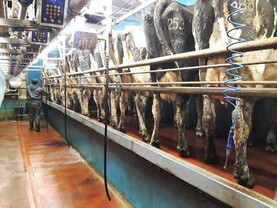As usual, the big two in Europe continue to set the tone for EU dairy markets. Right now, all eyes in dairy market circles are on Germany and France, Europe’s first- and second-largest milk-producing countries.
In the final months of 2018, milk production in both countries had fallen into reverse, with big declines seen in French milk output in particular. Fodder shortages following the summer drought was the primary reason for the decline in milk production in both countries.
The fodder shortages continued into early 2019 and resulted in continued weak milk production from Germany and France in the opening weeks of the year.
However, reports from the continent this week suggest milk supply in both countries has turned a corner and weekly milk production posted a slight rise compared with last year. Dairy buyers will be watching the big two very closely from now on.
Of the other large milk-producing countries, the start to the 2019 milking season has been very different.
In the UK, which is the third-largest milk producer in Europe, milk production for January was up 5% year on year to 1.25bn litres.
In Poland, January milk production increased more than 3% to hit just under 990m litres. And in Ireland, January milk production, albeit at a seasonal low, was up 1% to 160m litres.
The only exception to this is in the Netherlands, where January milk production fell 5% year on year to just over 1.1bn litres.
As usual, the big two in Europe continue to set the tone for EU dairy markets. Right now, all eyes in dairy market circles are on Germany and France, Europe’s first- and second-largest milk-producing countries.
In the final months of 2018, milk production in both countries had fallen into reverse, with big declines seen in French milk output in particular. Fodder shortages following the summer drought was the primary reason for the decline in milk production in both countries.
The fodder shortages continued into early 2019 and resulted in continued weak milk production from Germany and France in the opening weeks of the year.
However, reports from the continent this week suggest milk supply in both countries has turned a corner and weekly milk production posted a slight rise compared with last year. Dairy buyers will be watching the big two very closely from now on.
Of the other large milk-producing countries, the start to the 2019 milking season has been very different.
In the UK, which is the third-largest milk producer in Europe, milk production for January was up 5% year on year to 1.25bn litres.
In Poland, January milk production increased more than 3% to hit just under 990m litres. And in Ireland, January milk production, albeit at a seasonal low, was up 1% to 160m litres.
The only exception to this is in the Netherlands, where January milk production fell 5% year on year to just over 1.1bn litres.






 This is a subscriber-only article
This is a subscriber-only article










SHARING OPTIONS: